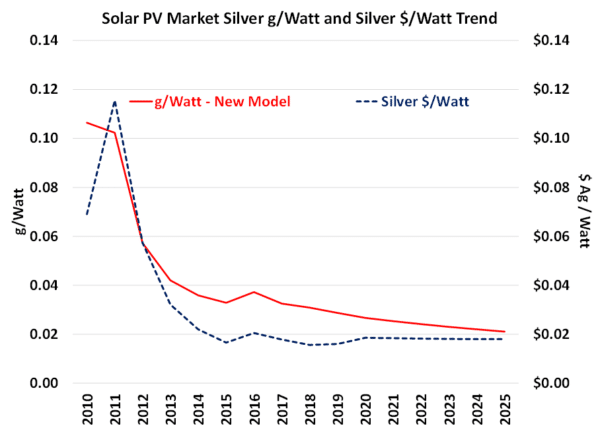The share of silver in PV module costs has risen by around 5% in recent months to account for approximately 10% of the total, according to U.S.-based analyst Matt Watson.
“With PV module costs in the neighborhood of $0.018-$0.019/watt and silver representing around 10% of the overall module cost structure, and module and cell prices still declining, finding a means to lower the silver cost component is going to become an increasingly difficult task,” Watson told pv magazine. “Over the past 20 years, silver has averaged an 8.31% year-on-year growth in prices, which is greater than the current rate of design thrifting. This means lowering that silver $/watt component is going to be very difficult.”
Watson noted that silver is now sold at around $26 per ounce, but said that prices will continue to climb.
“When you study the silver market, electronics demand, led by the Solar PV markets, all have increasingly larger forecast demand,” he said, noting that silver is becoming more of an industrial metal with each passing year. “The projected solar PV module silver cost per watt produced is leveling out going forward as a result of these silver price climbs … As other cell and module costs decline, silver will consume an even larger percentage of the overall module cost as these trends continue.”
Watson, a former executive at U.S.-based CIGS solar module manufacturer SoloPower, is currently the CEO and founder of California-based Precious Metals Commodity Management LLC. He said he believes that the PV industry will probably not move away quickly from the use of silver, despite the recent jump in silver prices.
“In my career, I did extensive work on alternatives alloys without any real success,” he said. “Life testing and electrical efficiency losses always brought us back to silver alloys.”
Watson said that engineering teams use precious metals in electronics for a reason.
“Silver of course is the most conductive mineral in the world, with good corrosion resistance properties assisting the durability of the module,” he added.

He acknowledged that nickel alloy has the potential to replace silver in solar cell metallization, but not in the space of a few years.
“We may need a couple of decades to get there,” he said, noting that in the connector market, copper and copper-nickel alloys are commonly used for both durability and electrical performance

In 2025, when around 230 GW of new capacity is expected, the industry will need 156 Moz, or 15% of the global silver supply.
“And this considering all of the silver design thrifting baselines,” Watson said. “With the growth in other electronics applications, I’m sure the real silver supply continuity pinch point is around 30% of the global silver supply. But at present course, we will hit that 30% silver demand level by around 2046.”
On the current solar PV market growth trajectory, by 2050 some 332 Moz of silver will be needed to support 1.33 TW/year of new installations.
“Clean energy voices calling for an even steeper growth in solar PV, to as high as 3 TWs to 4 TWs a year by 2050,” Watson concluded. “This trajectory of growth would break the silver market without substantial mining growth.”
This content is protected by copyright and may not be reused. If you want to cooperate with us and would like to reuse some of our content, please contact: editors@pv-magazine.com.




12 comments
By submitting this form you agree to pv magazine using your data for the purposes of publishing your comment.
Your personal data will only be disclosed or otherwise transmitted to third parties for the purposes of spam filtering or if this is necessary for technical maintenance of the website. Any other transfer to third parties will not take place unless this is justified on the basis of applicable data protection regulations or if pv magazine is legally obliged to do so.
You may revoke this consent at any time with effect for the future, in which case your personal data will be deleted immediately. Otherwise, your data will be deleted if pv magazine has processed your request or the purpose of data storage is fulfilled.
Further information on data privacy can be found in our Data Protection Policy.